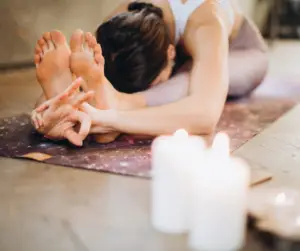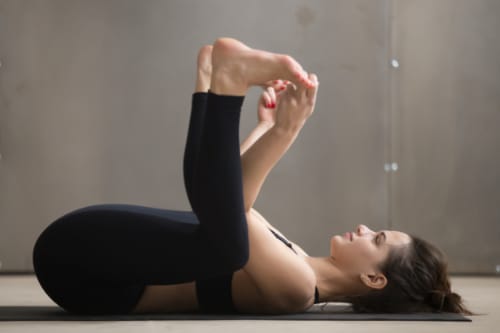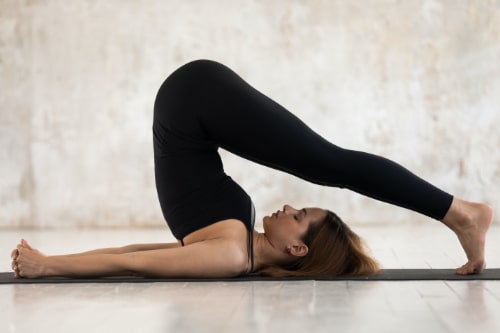
Yoga, an ancient practice spanning millennia, traces its origins to the teachings of Adiyogi, the inaugural practitioner, and Adiguru, the first instructor. Legends recount how they imparted these teachings to the revered Saptarishis, or seven sages, who disseminated this art worldwide. Rooted in the Sanskrit term “Yuj,” signifying unity, Yoga’s essence revolves around harmonizing the mind, body, and connection with nature. Over time, Yoga has emerged as a multifaceted remedy, addressing a spectrum of ailments, including mental well-being, weight management, bone ailments, and cognitive function.
But do you know that yoga can solve your gastric-related health problems?
Absolutely, yoga offers a range of poses specifically designed to help alleviate gastric-related health issues. The practice focuses on various postures and breathing exercises that can aid in improving digestion, reducing bloating, and soothing gastrointestinal discomfort. These yoga poses work to relax abdominal muscles, stimulate digestion, and promote overall gut health, providing potential relief from gastric concerns when practiced regularly and mindfully.
wind-relieving pose

Yes, the Wind-Relieving Pose (Pawanmuktasana) is known for its potential to aid in alleviating gastric discomfort. This yoga pose involves bringing the knees to the chest while lying on the back, which can help release trapped gas from the digestive system, reduce bloating, and ease digestive discomfort. It stimulates the abdominal muscles and can be beneficial in relieving gas-related pains when practiced regularly and gently. However, if you’re experiencing severe or persistent gastric pain, it’s essential to consult a healthcare professional for proper diagnosis and treatment.
wind-relieving pose benefits
The Wind-Relieving Pose (Pawanmuktasana) offers several potential benefits:
- Aids Digestion: This pose can stimulate the digestive organs, helping to improve digestion and relieve gas-related discomfort.
- Relieves Gas and Bloating: By compressing the abdomen, it helps release trapped gas, reducing bloating and discomfort in the stomach.
- Strengthens Abdominal Muscles: Regular practice can strengthen and tone the abdominal muscles, promoting better core strength.
- Improves Blood Circulation: The pose can enhance blood flow to the abdominal area, supporting organ function and overall circulation.
- Reduces Lower Back Tension: It can help alleviate tension in the lower back by gently stretching and releasing tension in the spine.
- Stimulates the Nervous System: This pose can have a calming effect on the nervous system, promoting relaxation and reducing stress.
- Aids in Detoxification: It may support the detoxification process by stimulating the digestive and elimination systems.
HOW TO DO IT
The Wind-Relieving Pose (Pawanmuktasana) is practiced in the following manner:
- Starting Position: Begin by lying flat on your back (supine position) on a yoga mat or a comfortable surface.
- Leg Movement: Inhale deeply. As you exhale, bend your knees and bring them toward your chest. You can keep both legs together or if comfortable, you can do one leg at a time, bringing each knee towards the chest.
- Interlock Fingers: Wrap your arms around your knees or shins and clasp your hands. You can also hold your elbows if it’s more comfortable.
- Head and Shoulders: Lift your head and shoulders slightly off the ground, aiming to touch your knees with your chin. However, if this feels straining, you can keep your head relaxed on the ground.
- Hold and Breathe: Maintain the position and hold for 20-30 seconds while breathing deeply and gently. You should feel a gentle stretch in your lower back and the compression in your abdomen.
- Release: As you inhale, gently release the pose by lowering your head and straightening your legs back to the starting position. Repeat if desired.
Child’s Pose

Child’s Pose (Balasana) can potentially help in alleviating gastric discomfort. This resting yoga pose involves sitting back on the heels and bending forward with the arms extended, which can gently compress the abdomen and help release trapped gas, easing bloating and digestive discomfort. It also relaxes the muscles in the lower back and abdomen, potentially providing relief from gastric pain when practiced mindfully and regularly. However, if you have severe or persistent gastric issues, it’s essential to consult a healthcare professional for proper diagnosis and treatment.
Child’s Pose Benefits
- Relieves Digestive Discomfort: It can help alleviate gas-related discomfort by gently compressing the abdomen, aiding in the release of trapped gas and reducing bloating.
- Stretches the Lower Back: This pose provides a gentle stretch to the lower back, promoting relaxation and potentially easing tension and discomfort in that area.
- Calms the Mind: The posture encourages relaxation and can have a calming effect on the mind, relieving stress and anxiety.
- Stretches the Hips, Thighs, and Ankles: It elongates and stretches the muscles in the hips, thighs, and ankles, offering relief from stiffness in these areas.
- Enhances Circulation: While in this pose, the breath deepens, potentially improving blood circulation throughout the body.
- Restorative and Rejuvenating: It’s often used as a resting pose during yoga practice, providing a moment of rest, allowing practitioners to regroup and re-energize.
- Promotes Mindfulness and Relaxation: Balasana encourages mindfulness by drawing attention to the breath and allowing for a meditative state.
How to do it?
- Starting Position: Begin by kneeling on the yoga mat. Sit back on your heels, keeping your big toes together and your knees about hip-width apart.
- Bend Forward: As you exhale, slowly lower your torso forward, allowing your belly to rest between your thighs.
- Arms Position: Extend your arms forward, placing them on the mat in front of you. Your palms should be facing down, and your arms can be straight or relaxed, depending on what feels comfortable.
- Forehead to the Mat: Gently lower your forehead to the mat. If your forehead doesn’t reach the ground, you can rest it on a yoga block, a folded blanket, or just keep it hovering above the mat.
- Relaxation: Relax your entire body in this position. Focus on breathing deeply and evenly, feeling the expansion of your ribcage with each inhale and the relaxation of your body with each exhale.
- Hold the Pose: Remain in this pose for several breaths or as long as it feels comfortable. You can hold it for 30 seconds to a few minutes, depending on your comfort level.
- Release: To come out of the pose, gently walk your hands back toward your body, slowly lifting your torso back to an upright seated position.
seated forward bend

The Seated Forward Bend (Paschimottanasana) can potentially aid in relieving digestive discomfort and gas-related issues. This yoga pose involves a forward fold that compresses the abdomen, which can stimulate the abdominal organs, improve digestion, and help relieve bloating or gas.
However, individual experiences may vary, and if you have severe or persistent gastric pain or digestive issues, it’s important to consult a healthcare professional for proper diagnosis and guidance. Additionally, practicing yoga poses should be done gently and within one’s comfort level to avoid any strain or discomfort.
Seated Forward Bend Benefits
- Aids Digestion: This pose compresses the abdominal area, stimulating the digestive organs, potentially improving digestion and alleviating gas-related discomfort.
- Stretches the Spine: It provides a deep stretch along the entire length of the spine, from the lower back to the neck, promoting flexibility and reducing stiffness.
- Relieves Stress and Calms the Mind: The forward fold encourages relaxation and can have a calming effect on the mind, reducing stress and anxiety.
- Stretches Hamstrings and Lower Back: It stretches the muscles in the back of the legs (hamstrings) and the lower back, potentially easing tension and improving flexibility in these areas.
- Enhances Blood Circulation: Paschimottanasana can improve blood circulation throughout the body, benefiting overall health.
- Stimulates Kidneys and Liver: The compression in the abdominal region may gently massage the kidneys and liver, supporting their function.
- Improves Posture and Alignment: Regular practice can help improve posture by stretching the spine and promoting proper alignment.
- Relaxing and Restorative: It’s often used in yoga practice as a calming and restorative pose, providing a moment of relaxation.
How to do it?
- Starting Position: Begin by sitting on a yoga mat with your legs extended straight in front of you. Ensure your spine is erect and your legs are together.
- Adjustment: If you have tight hamstrings or lower back discomfort, you can sit on a folded blanket or yoga block to elevate your hips slightly.
- Inhale and Lengthen: Inhale deeply and lengthen your spine, lifting your arms up toward the ceiling to elongate your torso.
- Forward Fold: As you exhale, hinge at your hips and slowly start to bend forward from the hips, not the waist. Maintain the length in your spine as you fold forward.
- Reach and Hold: Reach your arms toward your feet or shins, holding onto your legs, ankles, or feet—whichever is comfortable for you. If you can’t reach your feet, use a yoga strap around your feet to assist in the stretch.
- Keep Length in the Spine: Ensure your back remains as straight as possible, even if you can’t bend very far. Lengthening the spine is more important than touching your toes.
- Relax and Breathe: Relax into the stretch and breathe deeply. With each inhale, lengthen your spine, and with each exhale, fold a little deeper if comfortable.
- Hold the Pose: Hold this position for 30 seconds to a minute or longer, breathing smoothly and deeply. Be mindful of any strain or discomfort, and ease out of the pose if it becomes uncomfortable.
- Release: To come out of the pose, slowly and gently release the forward fold. Inhale and lift your torso back to an upright seated position.
The Supine Spinal Twist

The Supine Spinal Twist (Supta Matsyendrasana) can potentially aid in relieving digestive discomfort and gas-related issues. This yoga pose involves a twisting motion that can help massage and stimulate the abdominal organs, potentially improving digestion and alleviating bloating or gas.
However, the effectiveness can vary from person to person. If you’re experiencing severe or persistent gastric pain or digestive issues, it’s important to consult a healthcare professional for proper diagnosis and guidance. Also, practice yoga poses gently and within your comfort level to avoid any strain or discomfort.
Supine Spinal Twist Benefits
- Improved Digestion: The twisting motion massages the abdominal organs, potentially aiding digestion and relieving bloating or gas discomfort.
- Spinal Mobility: This pose gently stretches and mobilizes the spine, promoting flexibility and releasing tension in the back muscles.
- Relaxation and Stress Relief: The twist can have a calming effect, potentially reducing stress, anxiety, and promoting relaxation.
- Stretches and Relieves Tension: It stretches the hips, lower back, and glutes, potentially alleviating tension in these areas.
- Enhanced Spinal Health: Regular practice of spinal twists can promote spinal health by maintaining flexibility and mobility in the vertebrae.
- Improved Circulation: Twists may enhance blood flow to the abdominal organs, kidneys, and liver, aiding in their function.
- Detoxification: Some practitioners believe that twisting poses support the body’s natural detoxification process by stimulating organ function.
How to do it?
- Starting Position: Lie down on your back on a yoga mat with your legs extended.
- Preparation: Keep your arms extended alongside your body, palms facing down. Ensure your spine is aligned and relaxed.
- Bend Your Knees: Bend your knees, bringing them closer to your chest.
- Twist to One Side: Slowly lower both knees together to one side of your body while keeping your shoulders grounded on the mat. Extend your arms outward at shoulder level, palms facing down for stability.
- Gaze Direction: Turn your head in the opposite direction of your knees to deepen the spinal twist.
- Maintain the Twist: Keep both shoulder blades grounded, allowing your knees to gently press down toward the floor. If comfortable, you can place a prop like a yoga block or bolster under your knees for support.
- Breathe and Hold: Relax into the pose, and take slow, deep breaths. Hold the position for about 30 seconds to one minute, or as per your comfort level.
- Return to Center: Inhale and slowly bring your knees back to the center, returning to the initial lying-down position.
- Repeat on the Other Side: Repeat the twist on the opposite side by lowering your knees in the opposite direction, ensuring both sides of your body receive the stretch.
happy baby pose

Happy Baby Pose (Ananda Balasana) can potentially aid in relieving digestive discomfort, including gastric pain, by gently stretching the hips, inner groin, and lower back. However, its direct impact on gastric pain might vary among individuals.
The gentle stretching and pressure applied to the abdominal area in this pose could help in alleviating mild digestive issues and promoting relaxation. It may indirectly provide relief from gastric discomfort by releasing tension in the lower back and stimulating the digestive organs.
Happy Baby Pose Benefits
- Hip Flexibility: It gently stretches and opens the hips, groin, and inner thighs, promoting flexibility in these areas.
- Lower Back Relief: This pose can help release tension in the lower back and sacrum, potentially providing relief from mild lower back discomfort.
- Inner Thigh and Groin Stretch: It stretches and relaxes the inner thigh muscles (adductors) and groin area.
- Relaxation: The pose can induce a sense of relaxation and calmness due to its gentle nature, potentially reducing stress and anxiety.
- Digestive Aid: It may aid in relieving digestive discomfort by gently massaging the abdominal area and stimulating digestion.
- Improves Circulation: The posture may enhance blood circulation in the pelvis and lower back region.
- Stress Relief: Some practitioners find this pose mentally calming, helping to reduce stress and fatigue.
How to do it?
- Starting Position: Begin by lying on your back (supine position) on a yoga mat or comfortable surface.
- Bend Your Knees: Exhale and draw your knees toward your chest.
- Grip Your Feet: Reach for the inner arches or outer edges of your feet with your hands. You can also hold onto your ankles or shins if reaching your feet is challenging.
- Open Your Knees: Open your knees wider than your torso while keeping your ankles directly above your knees. Your shins should be perpendicular to the floor.
- Flexibility and Alignment: Flex your feet and gently press your feet up into your hands while pulling down with your hands to create resistance. This action helps in gently stretching the inner thighs and hips.
- Relax and Breathe: Relax your shoulders and lengthen your spine. Stay in the pose and breathe deeply, feeling the stretch in your hips and groin area.
- Hold the Pose: Hold the pose for about 30 seconds to one minute, or as per your comfort level, while maintaining steady breathing.
- Release: To exit the pose, release your feet and bring your knees back toward your chest. You can gently rock side to side to massage your lower back if desired.
plow pose yoga

Halasana, or the Plow Pose, can have some indirect benefits for digestive health. It stimulates the abdominal organs and may help improve digestion. However, whether it directly alleviates gastric pain can vary among individuals.
The gentle compression of the abdomen in this pose might stimulate the digestive organs, potentially aiding in digestion and easing discomfort. It’s essential to practice it mindfully and within your comfort level.
Always listen to your body, and if you experience any discomfort or have severe gastric pain, it’s best to consult a healthcare professional for proper diagnosis and guidance.
Plow Pose Benefits
- Stretches the Spine: It stretches and elongates the spine, promoting flexibility and relieving tension in the back.
- Stimulates Abdominal Organs: This pose can stimulate the abdominal organs, potentially aiding digestion and metabolism.
- Relief for Backache: It may help alleviate mild backaches and discomfort in the lower back.
- Stress Reduction: The pose can induce relaxation and calmness, potentially reducing stress and anxiety.
- Improves Blood Circulation: It enhances blood circulation to the neck, shoulders, and face while calming the nervous system.
- Therapeutic for Thyroid: Halasana stimulates the thyroid gland, potentially aiding in regulating metabolism.
- Strengthens Muscles: It engages and strengthens the core muscles, particularly the abdominal muscles.
How to do it?
- Starting Position: Lie flat on your back (supine position) with your arms alongside your body, palms facing down.
- Leg Lift: As you inhale, use your abdominal muscles to lift your legs off the floor, keeping them straight. Use your hands on the floor to support and stabilize your hips as you lift your legs.
- Raise Hips: Continue lifting your legs, bringing them over your head, aiming to bring your toes to touch the floor behind your head. Your back should be perpendicular to the ground, and your legs should be straight.
- Support Your Back: If you’re unable to reach the floor with your toes, support your lower back with your hands and keep your elbows close together on the ground.
- Leg Position: Keep your legs straight, feet together, and toes pointed upward. Try to maintain a straight line from your neck to your tailbone.
- Hold the Pose: Stay in the pose for several breaths, aiming for 30 seconds to one minute, while breathing deeply and evenly.
- Release: To exit the pose, slowly roll your spine back down onto the mat, lowering one vertebra at a time until your legs are on the ground.
Important: If you have any neck, back, or spinal issues, or if you feel any discomfort during the pose, avoid this posture. Pregnant women and individuals with high blood pressure or other medical conditions should also avoid practicing Halasana unless under the guidance of a qualified yoga instructor or healthcare professional. Always perform yoga poses mindfully and within your comfort level.
Frequently Asked Questions (FAQs)
What is Yoga?
Yoga is an ancient practice originating in India that combines physical postures, breathing exercises, and meditation to promote holistic health and well-being.
Can Yoga Poses Help Alleviate Gastric Pain?
Yes, certain yoga poses are believed to aid in relieving gastric discomfort by facilitating digestion and reducing bloating and gas.
Which Yoga Poses Are Beneficial for Gastric Pain?
Poses like Wind-Relieving Pose (Pawanmuktasana), Child’s Pose (Balasana), Supine Spinal Twist (Supta Matsyendrasana), and Seated Forward Bend (Paschimottanasana) are known to be helpful for gastric issues.
How Do Yoga Poses Relieve Gastric Pain?
These poses typically involve gentle compression, twisting, or stretching of the abdominal area, which can stimulate digestion, improve blood flow, and release tension in the gut.
Are There Any Precautions Before Practicing These Poses?
Individuals with severe or chronic gastric conditions should practice these poses gently and under the guidance of a qualified yoga instructor or healthcare professional.
How Often Should I Practice Yoga Poses for Gastric Pain?
Consistent practice, a few times a week, can help in managing gastric discomfort. However, start slowly and gradually increase intensity and duration.
Can Beginners Practice Yoga Poses for Gastric Pain?
Yes, beginners can start with gentle versions of these poses and gradually progress as their comfort and flexibility improve.
Can Yoga Poses for Gastric Pain Replace Medical Treatment?
While yoga poses may offer relief, they shouldn’t replace medical treatment. Individuals with severe or persistent gastric issues should consult healthcare providers for proper diagnosis and treatment.
Is It Necessary to Practice These Poses on an Empty Stomach?
It’s recommended to practice yoga poses for gastric pain on an empty stomach or a few hours after a meal for better comfort and ease.
How Long Should I Hold These Poses?
Hold each pose for a comfortable duration, aiming for about 30 seconds to one minute, and focus on deep and relaxed breathing while holding the posture.
Are There Any Side Effects of Practicing These Poses?
These poses are generally safe but listen to your body. If you feel discomfort or pain, ease out of the pose and consult a yoga instructor or healthcare provider.
What are the Different Types of Yoga?
There are various styles of yoga, such as Hatha, Vinyasa, Ashtanga, Bikram, Iyengar, Yin, and more, each emphasizing different aspects like flow, alignment, breath, or heat.
What are the Benefits of Practicing Yoga?
Yoga offers numerous benefits, including improved flexibility, strength, balance, reduced stress, better mental focus, enhanced breathing, and relaxation.
Can Yoga Help with Specific Health Conditions?
Yes, yoga has been shown to aid in managing conditions like anxiety, depression, chronic pain, cardiovascular health, diabetes, and even improving sleep quality.
How Often Should I Practice Yoga?
The frequency of yoga practice varies among individuals. It can be practiced daily or a few times a week, depending on personal goals and schedules.
What Equipment Do I Need for Yoga?
Yoga generally requires minimal equipment. A yoga mat is essential for most practices, and props like blocks, straps, or bolsters might be used to assist in certain poses.
Can Beginners Start Yoga?
Absolutely! Many yoga classes cater to beginners, offering modifications and guidance to gradually build strength, flexibility, and understanding of the practice.
Is Yoga Only Physical Exercise?
While yoga includes physical postures (asanas), it’s not solely about exercise. Yoga combines physical movement, breathwork, and mindfulness, aiming for holistic well-being.
Is Yoga Safe for Everyone?
Generally, yoga is safe for most people. However, individuals with certain medical conditions, injuries, or pregnancies should consult healthcare providers before starting a yoga practice.
